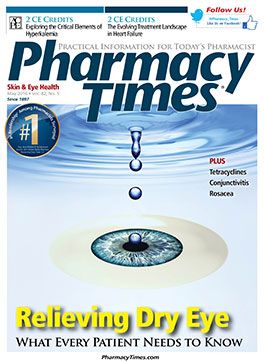Self-Care for Skin and Eye Disorders
Which OTC products should these pharmacists recommend?
CASE 1: DRY EYES
A 35-year-old man comes to the pharmacy looking for a product for his dry eyes. He says that for the past few weeks, his eyes have felt very tired, as he has been using a computer more at his work. He went to an eye doctor, who said he is suffering from mild dry eyes. The doctor recommended he use something over-the-counter. The patient is not taking any medications and has no other medical conditions. He is confused about which product to take. What would you recommend to help relieve this patient’s dry eyes?
ANSWER
Most patients who come to the pharmacy with dry eyes typically have not gotten a diagnosis of the condition. Therefore, we typically look for symptoms such as tired or red eyes. Because this patient has been given a diagnosis of dry eyes, we can recommend any ophthalmic lubricant, such as Systane, Teargen II, Soothe, Tears Naturale, or GenTeal Lubricant Eye Gel. A few formulations are on the market. Drops are typically used during the day, and formulations made with gels are recommended for use at night and are typically reserved for more severe cases.1 The patient should follow the package’s directions for use, which typically recommend application of drops 1 or 2 times daily for mild dry eyes. If he has severe dry eyes, he can use the drops up to 4 times daily, and overnight gel therapy should be recommended. In addition to using drops, the patient could decrease or avoid computer use, as it can lead to dry eyes. Warm compresses and protective eye equipment may also help decrease his dry eyes.1
CASE 2: LICE
A 29-year-old mother comes to the pharmacy looking for treatment for lice for her 6-year-old daughter. This is the first time this mother has had lice in her household and she feels very overwhelmed. She thinks her daughter got it from school and says her daughter has been complaining about itching on her head. When she tried to remove what looked like dandruff from her daughter’s hair, the gray/ white speck was firmly attached to the hair shaft. Her friend said it is lice, but she is not sure. What recommendation do you have for this mother?
ANSWER
Lice are easily identified by their firm attachment to the hair shaft. Head lice are common in school-age children and appear to be white or gray. Two ingredients— pyrethrin and permethrin—are available for treating lice. Pyrethrins are typically used in combination with piperonyl butoxide to help kill lice. Patients should be educated to follow the directions on the package. Both treatments are typically left on the hair for 10 minutes. Whereas pyrethrin requires a second application 7 to 10 days later to kill nits that may have hatched since the first treatment, permethrin is not applied again unless active lice are detected. Because the products do not kill 100% of the nits, a nit comb should be used with these products, many of which come with the comb. The adverse effects of both products are similar; however, permethrin is more effective after one treatment.2
CASE 3: SUNBURN
A 32-year-old woman comes to the pharmacy looking for a product to protect her from sunburn. Her family is planning on going to Hawaii next week. She says that the last time they went on vacation, she forgot to buy sunscreen; her family got sunburnt on the first day, and the trip was ruined. She also worries about the exposure causing cancer. She wants to know what you recommend for her if she is planning on being in the water some of the time, but also lying out in the sun. She wants to know if you recommend a specific SPF for sunscreen and which products are effective?
ANSWER
It is most important to educate this customer on avoiding or minimizing her sun exposure. The sun’s rays are most damaging between 10 am and 4 pm. She should try to avoid the sun during this time; however, it sounds like she will be exposed to the sun most of the day. If she cannot avoid it, she should try to wear protective clothing, such as hats and long-sleeve shirts, or use protective equipment, such as a beach umbrella. An SPF of 15 or higher provides the greatest protection. She should consider buying a product that protects against ultraviolet A and B rays. These products contain octocrylene, meradimate, titanium dioxide, benzophenones, or avobenzone with padimate O. She should be taught to apply sunblock at least 15 minutes before sun exposure. If she is planning to go into the water, she should buy a water-resistant product and apply it every 40 to 80 minutes. Non—water-resistant products can be applied every 2 hours. Reapplication is the best way to protect her family against the sun’s rays.
Dr. Mansukhani is a clinical assistant professor at the Ernest Mario School of Pharmacy, Rutgers University, and a transitions-of-care clinical pharmacist at Morristown Medical Center in Morristown, New Jersey. Dr. Bridgeman is a clinical associate professor at the Ernest Mario School of Pharmacy, Rutgers University, and an internal medicine clinical pharmacist at Robert Wood Johnson University Hospital in New Brunswick, New Jersey.
References
- Ophthalmic disorders. In: Krinsky DL, Ferreri SP, Hemstreet B, et al, eds. Handbook of Nonprescription Drugs: An Interactive Approach to Self-Care. 18th ed. Washington, DC: American Pharmacists Association; 2015.
- Insect bites and stings and pediculosis. In: Krinsky DL, Ferreri SP, Hemstreet B, et al, eds. Handbook of Nonprescription Drugs: An Interactive Approach to Self-Care. 18th ed. Washington, DC: American Pharmacists Association; 2015.

